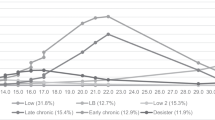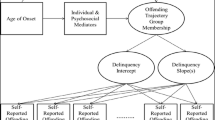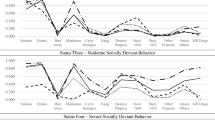Abstract
This article identifies the arrest trajectories of youth from ages 12 through 24 years old and tests hypotheses derived from Moffitt’s developmental taxonomic theory of crime concerning the impact of various emotional disturbances on the specific trajectories of the youth involved. The study uses exclusively administrative data sets and includes a gender and racially diverse sample of 10,360 youth (30.7 % females) who were arrested at least once between ages 12 and 24 in the early 2000s. Latent class growth analysis was employed in order to identify distinct arrest trajectories of youth in the sample. Multinomial logistic regression was used to identify diagnostic and other characteristics associated with membership in the specific trajectories predicted by Moffitt’s theory. Five trajectory classes were identified, 3 of which were consistent with taxonomic theory including high and classic adolescence limited trajectory classes and a “snared adolescence limited class” described more recently by Moffitt. The distribution of youth among the 5 classes was very different for those with and without emotional disturbances. Youth with emotional disturbances in their late adolescent years were more likely to fall into the high arrest trajectory class and much less likely to fall into the low arrest trajectory class. Compared to youth without an emotional disturbance, youth with psychotic disorders were more than twice as likely to fall into the high as into the low arrest trajectory class. Youth with disruptive behavior disorders were more than twice as likely to fall into the high and intermediate classes as into the low trajectory class. Anxiety and depressive disorders were not associated with significantly greater likelihood of falling into any one of the trajectory classes. Youth in the snared adolescence limited class were more likely than those in the classic adolescence limited class to be male, black versus white and in the foster care enrollment category lending some support to Moffitt’s conceptualization of this class as an adolescence limited class composed of youth who are snared by involvement in the criminal justice and or social services systems. Implications of these results for public policy and the study of adolescence are discussed.


Similar content being viewed by others
References
American Psychiatric Association. (2000). Diagnostic and statistical manual of mental disorders (4th ed.). Washington, DC: American Psychiatric Association.
Bauer, D. J., & Curran, P. J. (2003). Distributional assumptions of growth mixture models: Implications for overextraction of latent trajectory classes. Psychological Methods, 8, 338–363.
Bryant, F. B., & Satorra, A. (2012). Principles and practice of scaled difference Chi square testing. Structural Equation Modeling, 19, 372–398.
Chung, I., Hill, K., Hawkins, J., Gilchrist, L., & Nagin, D. (2002). Childhood predictors of offense trajectories. Journal of Research in Crime and Delinquency, 39, 60–90.
Cohen, M. A., & Piquero, A. R. (2009). New evidence on the monetary value of saving a high risk youth. Journal of Quantitative Criminology, 25(1), 25–49.
Constantine, R. J., Petrila, J., Andel, R., Givens, E. M., Becker, M., Robst, J., et al. (2010). Arrest trajectories of adult offenders with a serious mental illness. Psychology, Public Policy & Law, 16, 319–418.
Constantine, R. J., Robst, J., Andel, R., Jones, M. E., McPherson, M. A., & Givens, E. M. (2013). Service and medication use and their effects on arrest rates among children with emotional disturbances before disenrollment from Medicaid. Journal of Child and Family Studies. doi:10.1007/s10826-013-9746-x.
Copeland, W. E., Miller-Johnson, S., Keeler, G., Amgold, A., & Costello, E. J. (2007). Childhood psychiatric disorders and young adult crime: A prospective population-based study. American Journal of Psychiatry, 164, 1668–1675.
D’Unger, A., Land, K., McCall, P., & Nagin, D. (1998). How many latent classes of delinquency/criminal careers? Results from a mixed poisson regression analyses. The American Journal of Sociology, 103(6), 1593–1630.
Davis, M., Banks, S., Fisher, W., & Grudzinskas, A. (2004). Longitudinal patterns of offending during the transition to adulthood in youth from the mental health system. Journal of Behavioral Health Services & Research, 31(4), 351–366.
DeLisi, M., & Piquero, A. R. (2011). New frontiers in criminal careers research, 2000–2011: A state-of-the-art review. Journal of Criminal Justice, 39(4), 289–301.
D’Unger, A., Land, K., & McCall, P. (2002). Sex differences in age patterns of delinquent/criminal careers: Results from Poisson latent class analyses of the Philadelphia cohort study. Journal of Quantitative Criminology, 18(4), 349–375.
Farrington, D. P. (2003). Key results from the first forty years of the Cambridge Study in delinquent development. In T. P. Thornberry & M. D. Krohn (Eds.), Taking stock of delinquency: An overview of findings from contemporary longitudinal studies (pp. 137–183). Boston: Kluwer.
Fergusson, D., & Horwood, L. (2002). Male and female offending trajectories. Development and Psychopathology, 14, 159–177.
Jennings, W., & Reingle, J. (2012). On the number and shape of developmental/life-course violence, aggression, and delinquency trajectories: A state-of-the-art review. Journal of Criminal Justice, 40, 472–489.
Kreuter, F., & Muthen, B. (2007). Analyzing criminal trajectory profiles: Bridging multilevel and group-based approaches using growth mixture modeling. Journal of Quantitative Criminology, 24(1), 1–31.
MedicaidProgram. (2013). Florida Medicaid Program. Retrieved May 23, 2013 from http://www.medicaidprogram.net/articles/137723/Florida-Medicaid-Program.
Moffitt, T. E. (1993). “Life-course-persistent” and “adolescence-limited” antisocial behavior: A developmental taxonomy. Psychological Review, 100, 674–700.
Moffitt, T. E. (2006). A review of research on the taxonomy of life-course persistent versus adolescence-limited antisocial behavior. In F. T. Cullen, J. P. Wright, & K. R. Blevins (Eds.), Taking stock: The status of criminological theory (Vol. 15, pp. 277–312). New Brunswick, NJ: Transaction Publishers.
Moffitt, T. E. (2007). A review of research on the taxonomy of life-course persistent versus adolescence-limited antisocial behavior. In D. Flannery, A. Vazsonyi, & I. Waldman (Eds.), The Cambridge handbook of violent behavior and aggression (pp. 49–74). New York: Cambridge University Press.
Moffitt, T. E., Caspi, A., Harrington, H., & Milne, B. J. (2002). Males on the life-course-persistent and adolescence-limited antisocial pathways: Follow-up at age 26 years. Development and Psychopathology, 14, 179–207.
Moffitt, T. E., & Silva, P. (1988). Self-reported delinquency, neuropsychological deficit, and history of attention deficit disorder. Journal of Abnormal Child Psychology, 16(5), 553–569.
Muthen, B. (2003). Statistical and substantive checking in growth mixture modeling: Comment on Bauer and Curran (2003). Psychological Methods, 8, 369–377.
Muthen, L. K., & Muthen, B. O. (2007). Mplus user’s guide (5th ed.). Los Angeles, CA: Maryland Population Research Center.
Nagin, D. S. (2005). Group-based modeling of development. Cambridge, MA: Harvard.
Newman, D. L., Moffitt, T. E., Caspi, A., Magdol, L., Silva, P. A., & Stanton, W. R. (1996). Psychiatric disorder in a birth cohort of young adults: Prevalence, comorbidity, clinical significance, and new case incidence from ages 11–21. Journal of Consulting and Clinical Psychology, 64(3), 552.
Piquero, A. R. (2008). Taking stock of developmental trajectories of criminal activity of the life course. In A. Liberman (Ed.), The long view of crime: A synthesis of longitudinal research (pp. 23–78). New York: Springer.
Piquero, A. R. (2011). Invited address: James Joyce, Alice in Wonderland, the rolling stones, and criminal careers. Journal of Youth and Adolescence, 40(7), 761–775.
Piquero, A. R., Farrington, D. P., & Blumstein, A. (2003). The criminal career paradigm. In M. Tonry (Ed.), Crime and justice: A review of research (Vol. 30, pp. 359–506). Chicago: University of Chicago Press.
Raine, A., Moffitt, T., Caspi, A., Loeber, R., Stouthamer-Loeber, M., & Lynam, D. (2005). Neurocognitive impairments in boys on the life-course persistent antisocial path. Journal of Abnormal Psychology, 114(1), 38–49.
Rosenblatt, J. A., Rosenblatt, A., & Biggs, E. E. (2000). Criminal behavior and emotional disorder: Comparing youth served by the mental health and juvenile justice systems. The Journal of Behavioral Health Services & Research, 27(2), 227–237.
SAS Institute. (2008). SAS/STAT 9.2 user’s guide. Cary, NC: SAS Institute, Inc.
Sullivan, C. J., & Piquero, A. R. (2011). Criminal career research: A statistical and substantive comparison of growth modeling approaches. In J. MacDonald (Ed.), Measuring crime and criminality, advances in criminological theory, Vol. 17. New Brunswick, NJ: Transaction.
Teplin, L. A., Abram, K., McClelland, G. M., Dulcan, M. K., & Mericle, A. A. (2002). Psychiatric disorders in youth in juvenile detention. Archives of General Psychiatry, 59, 1133–1143.
Unruh, D., Povenmire-Kirk, T., & Yamamoto, S. (2009). Perceived barriers and protective factors of juvenile offenders. Journal of Correctional Education, 60(3), 201–224.
U.S. Public Health Service. (1999). Mental health: A report of the Surgeon General. Washington, DC: Author.
Wasserman, G., Ko, S. J., Larkin, S., & McReynolds, M. (2004). Assessing the mental health status of youth in juvenile justice settings. Washington, DC: Office of Juvenile Justice and Delinquency Prevention.
Wiesner, M., Capaldi, D. M., & Kim, H. K. (2007). Arrest trajectories across a 17-year span for young men: Relation to dual taxonomies and self-reported offense trajectories. Criminology, 45(4), 835–863.
Wiesner, M., & Silbereisen, R. (2003). Trajectories of delinquent behavior in adolescence and their covariates: Relations with initial and time-averaged factors. Journal of Adolescence, 36, 753–771.
Acknowledgments
The research was supported by the Florida Agency for Health Care Administration, Tallahassee, Florida. Special thanks to Mary Beth Jones, R. Ph.
Author contributions
R.C. conceived of the study and drafted the manuscript and response to reviewers. R.A. did the analysis and drafted the Results Section of the article. J.R. edited and added to the manuscript. E.G. edited and added to the document and handled the references and formatting of the manuscript.
Author information
Authors and Affiliations
Corresponding author
Rights and permissions
About this article
Cite this article
Constantine, R.J., Andel, R., Robst, J. et al. The Impact of Emotional Disturbances on the Arrest Trajectories of Youth as They Transition into Young Adulthood. J Youth Adolescence 42, 1286–1298 (2013). https://doi.org/10.1007/s10964-013-9974-9
Received:
Accepted:
Published:
Issue Date:
DOI: https://doi.org/10.1007/s10964-013-9974-9




